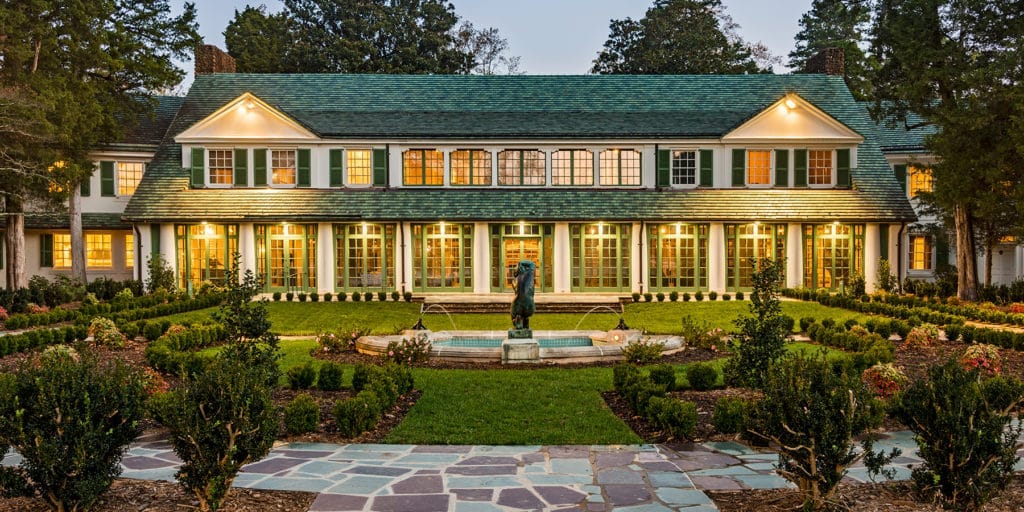Katharine Reynolds created the estate herself, the home she had dreamed about since her teens. Defying societal norms for women, she mastered her own world, planning and building Reynolda, leaving RJR in the background. Soon after their marriage, the couple began buying tracts of land, finally assembling 1,067 acres three miles north of Winston.
Katharine meticulously managed every detail of her vision. Over 12 years, she transformed a thousand acres of poor soil into a lush landscape with forests, pastures, gardens, a pool, and a man-made lake. Reynolda had fruit trees, flowers, vegetables, a Colonial Revival residence, a greenhouse, a working farm, a golf course, tennis courts, stables, and a church. She even demanded first-class telephone service for the estate. Her goal was for Reynolda to serve as a self-sustaining model and an inspiration to the working class.
Her obsession with Reynolda was total. She wrote to her architect about the 64-room bungalow, "I am anxious for it to be a beautiful as well as a comfortable house." She oversaw all the contractors, paid the bills - including all household accounts - and kept an eye on the costs. She read blueprints nearly as well as an engineer. The construction employed hundreds of workmen.
RJR’s wealth enabled her vision. In one 6-month period, he gave her $120,000 (C$3.8 million). The total cost of the estate was estimated to be around $6 million ($C138 million), covering the house, furnishings, roads, land, and development.
By 1918, Katharine had created her own world. Reynolda was one of the showcase properties of the Southeast, featured in House Beautiful and admired for its elegance.
She addressed cultural and agricultural needs in Piedmont North Carolina. One notable event was a grand lakeside pageant based on Longfellow’s Hiawatha performed for an audience of 5,000. Music was an integral part of life at Reynolda. She even bought a $30,000 (C$815,000) Aeolian organ. This reflected both her passion for music and her family's wealth, comparable to that of the Carnegies and Rockefellers.
Katharine envisioned Reynolda as a model farm to improve the lives of local farmers. Many of the poorest families ate little more than cornmeal, molasses, and pork. She used Reynolda to experiment with better farming methods to improve life for local farmers.
Part of her vision at Reynolda was cleanliness and disease prevention. She demanded state-of-the-art technology and hygiene practices in her cow barn and milk room. She even installed an electric refrigeration plant to keep milk to ensure a safe storage temperature.
Design and construction of Reynolda House began in 1912 and continued through 1917. Katharine hired Philadelphia architect Charles Barton Keen, to design the Reynolda buildings and Thomas W. Sears for the gardens. The house cost $200,000 (C$ 4.6 million). The family moved there in December 1917. Sadly, R. J. Reynolds, suffered from pancreatic cancer, was unable to enjoy his new home, and died July 29, 1918.
In 1935, Mary Reynolds Babcock, Katharine’s elder daughter, acquired the estate. She and her husband, Charles Babcock, made it their home in 1948. The estate became affiliated with Wake Forest University in 2002.
The formal Reynolda Gardens combined southeastern native plants with Japanese architecture and classical European designs. The Lord & Burnham greenhouse was built in 1913. Landscape architect Thomas W. Sears designed the four-acre formal garden in 1915. Between 1958 and 1962, Mary Reynolds Babcock the garden property to Wake Forest University. In 1995, the University and the National Park Service restored the garden to its original design.
Reynolda Village included employee residences, blacksmith shop, dairy, stables, mule barn, henhouse, cattle barn, smokehouse, corn shed, garage, heating plant, laundry, schools, post office, farmhouse, and a church. Four of the cottages were still used in the 1980 assessment of the village for its nomination to the National Register of Historic Places. The former farmhouse served as a men's boarding house until World War II.
After Katharine’s (then Mrs. Johnston) death, in 1924 most of the property was gradually sold or donated, including 300 acres given to Wake Forest College in the late 1940s for its new Winston-Salem campus.
Visit this REYNOLDA LINK for more information about Reynolda and Reynolds family history.
Today, at Reynolda, Lake Katharine has reverted to wetlands for wildlife. The restored formal gardens feature Japanese cryptomeria and weeping cherry trees. Reynolda Village now has boutiques, shops, and restaurants. A short walking path connects the Village to Wake Forest University. The Village and adjacent Reynolda Gardens, Deeded to Wake Forest University in 1965, The Village and Gardens, are under its care.
REYNOLDA HOUSE AND MUSEUM OF AMERICAN ART
Opened to the public in 1965 and designated a museum in 1967, Reynolda House and Museum holds a premier collection of American art. The artworks are displayed throughout the historic home, with its rooms and furnishings preserving the period when the Reynolds family lived there.
REYNOLDA GARDENS
Reynolda Gardens has 125 acres of woodlands, fields, wetlands, a formal garden, and greenhouse. The Greenhouse Gardens, designed between 1917 and 1931, span 2 acres and feature a variety of flowers and trees. Visitors can explore several miles of woodland trails on the property.
REYNOLDA VILLAGE
Reynolda Village covers 13.5 acres and is part of the Reynolda Historic District, with 22 of its buildings listed on the National Register of Historic Places. Some structures were built using fieldstone from the estate. The cattle shed, corn crib, and chicken house were reconstructed in the late 1970s. Reynolda Church stands nearby. Today, former dairy barns, cattle sheds, and cottages have been transformed into shops, restaurants, and offices.






We visited Reynolda at your suggestion Gene…a very enjoyable tour! Great story about Katharine.
Very nice story. Thanks Gene.